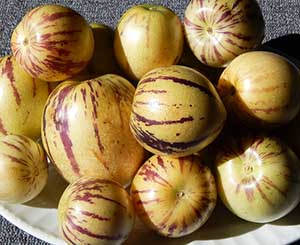Pepino melon Nutrition facts
Pepino melon is a juicy, delicious, pleasantly fragrant berry grown from the foothills of the South American Andes Mountains. It belongs to the nightshade or Solanaceae, the same family as tomatoes, eggplants and capsicums.
This little-known fruit is naturally adapted to low-lying forests of the Andean mountains of Peru, Colombia, and Bolivia. In the US, California State produces them at a commercial scale but its production is limited to local consumption. Now-a-days, New Zealand and Australia are growing them for exporting purposes.
Scientific name: Solanum muricatum. Some of the common names include mellow fruit, tree melon, melon pear, sweet cucumber (pepino dulse), and melon shrub.
 |
| Fresh pepino melons. Photo courtesy: Forest and Kim Starr |
Pepino (Melon Pear) is an annual, semi-dense, small shrub that grows about 1–2 meters tall. It thrives best in well-drained loamy soil and frost-free climates. The plant has deep green, elongated leaves resembling those of capsicum plants, though larger in size.
Beautiful light-blue flowers bloom and develop into fruits within 30–50 days. The fruits vary in color, shape, and size, generally being light yellow with smooth skin and purple speckles. They are ovate to elongated, approximately the size of a small orange, and typically weigh 300–500 grams.
Inside, the flesh is smooth, juicy, and cream-textured, offering a sweet flavor similar to honeydew melon. The seeds are edible, making Pepino fruit both nutritious and delicious.
Health Benefits of Pepino Melon
Pepino melons are low-calorie fruits rich in phytonutrients, dietary fiber, essential minerals, and vitamins that promote overall health and wellness.
The powerful antioxidants in pepinos exhibit anti-inflammatory and skin-protective effects and may help in the prevention of cancers.
Yellow-fleshed Pepino fruits contain valuable phenolic compounds such as β-carotene and zeaxanthin. Zeaxanthin plays a key role in protecting the retina from age-related macular degeneration (ARMD) by filtering harmful ultraviolet rays, especially in older adults.
Along with β-carotene, Pepino melons provide moderate levels of vitamin A and flavonoid antioxidants such as lutein. These pigment compounds possess strong antioxidant properties that support night vision, maintain healthy skin, mucosa, and bones, and may help protect against lung and oral cavity cancers.
Fresh Pepino melon is a good source of vitamin C. Regular consumption of vitamin-C-rich foods strengthens the immune system, helps fight infections, and neutralizes free radicals in the body.
The fruit also contains a moderate amount of potassium—an essential mineral that maintains heart health and helps regulate blood pressure by balancing the effects of sodium.
Pepino melon provides moderate levels of important B-complex vitamins like thiamin, niacin, folic acid, and riboflavin. It also supplies key minerals such as phosphorus, iron, calcium, manganese, and trace elements that support metabolism and energy production.
In traditional medicine, Pepino is believed to have antirheumatic properties and is used to treat respiratory infections and various skin problems.
| Principle | Nutrient Value | Percentage of RDA |
|---|---|---|
| Energy | 22 Kcal | 1% |
| Carbohydrates | 5 g | 4% |
| Protein | 0.6 g | 1% |
| Total Fat | 0.1 g | <1% |
| Cholesterol | 0 mg | 0% |
| Dietary Fiber | 1 g | 2% |
Selection and Storage
In the United States, the fresh harvest of Pepino melons reaches local markets around June. They appear in a variety of colors and sizes. Always choose bright-colored, firm, and intact fruits with a pleasant, delicate aroma.
If you purchase mature but unripe pepinos, allow them to ripen at room temperature. They can stay fresh for up to one week. Once fully ripened, it’s best to consume them immediately or refrigerate for only 1–2 days to maintain flavor and texture.
Preparation and Serving Methods
Always wash the fruit thoroughly under clean running water before use.
Unripe Pepino melon can be cooked like squash, while ripe ones are enjoyed fresh, similar to honeydew melon.
To prepare: remove the stem and calyx end, cut the fruit lengthwise using a paring knife, and scoop out the seed-filled cavity with a spoon. The seeds are edible. Then slice into sections or wedges as desired. Proper ripeness enhances the fruit’s flavor, aroma, and appeal.
Serving Tips:
Enjoy Pepino melon fresh, as is—no additions needed.
Add it to mixed fruit salads or serve with a dash of lemon or lime juice for extra zest.
Safety Profile
As a member of the Solanaceae family, Pepino melons may cause allergic reactions in some sensitive individuals. Common symptoms include skin or eye itching, runny nose (allergic rhinitis), and gastrointestinal discomfort such as stomach pain, vomiting, or diarrhea. In most cases, stomach pain is self-limiting.
Individuals with pepino intolerance may experience cross-allergic reactions to other Solanaceae family members like eggplant, tomato, or peppers. Such individuals are advised to consult a family physician before consuming Pepino melon.
(Medical Disclaimer).
Read further on:
≻≻-Cantaloupe (muskmelons) Nutrition Facts and health benefits.
≻≻ Do Potassium-Rich Foods Help Lower Blood Pressure?
≻≻-Horned Melon Nutrition Facts and health benefits.
≻≻-Back to Fruits from Pepino melon. Visit here for an impressive list of fruits with complete illustrations of their nutrition facts and health benefits.
≻≻-Back to Home page.
Further reading:
Novel Farm Development Trial with PEPINO. (Link opens in new window).
Exotic Pepino: A Shrub for Prophylactic Consequence & Nutritional Regime.